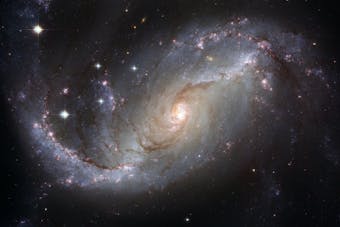A discovery that links the intimate and the infinite
Imagine someone told you that the fabric of your brain and the structure of the universe share the same design. That you, in your seemingly small existence, are made from the same pattern as galaxies. It sounds poetic — but it’s science.
In 2020, astrophysicist Franco Vazza and neurosurgeon Alberto Feletti conducted a study that astonished the scientific community. They found striking mathematical and structural similarities between the human brain’s neural network and the cosmic web that connects galaxies across the observable universe.
Two worlds, one pattern
At first glance, the brain and the universe couldn’t be more different — one is organic, wet, and electric; the other is vast, cold, and governed by gravity. Yet both function as complex networks made of interlinked nodes. In the brain, the nodes are neurons; in the cosmos, galaxies.
What’s most astonishing is that when Vazza and Feletti analyzed how these nodes are distributed and connected, they discovered nearly identical statistical parameters:
- On average, each node (neuron or galaxy) connects to 4–5 neighbors.
- Only about 30% of the total mass in each system forms part of the active network — the rest remains inactive or supportive.
- The density fluctuations — how matter clusters or disperses — follow similar mathematical patterns.
What science is telling us
The researchers are not claiming that the universe is a brain or that it thinks. But they do suggest that similar organizational laws might govern both systems. In essence, the brain and the cosmos might be examples of how nature optimizes connectivity and information flow, whether via synapses or intergalactic filaments.
These kinds of structures appear elsewhere too — in the internet, vascular systems, and even social networks. They all seem to follow a shared logic of efficiency, where what matters is not just what connects, but how it connects.
What if the universe isn’t so different from you?
When you compare images of cerebellar tissue and cosmic web simulations, it’s genuinely hard to tell them apart. The forms intertwine like they’re speaking an ancient, shared language — one that predates life itself. And that leads to a question that touches something deeper than science:
What if the universe is more than a stage? What if we are part of its way of knowing itself?
The brain is how we perceive the universe. But perhaps it’s also how the universe perceives itself — through us.
Information and memory: Two giants face to face
Another curious fact is how much information each system can theoretically store. The human brain is estimated to hold 2.5 petabytes of data. The cosmic web, if approached as an information system, could hold up to 4.3 petabytes. Not bad for a network of galaxies scattered across billions of light-years.
What does this mean for you?
This study is fascinating not only for what it reveals, but also for what it suggests: that the micro and the macro are deeply connected, not just by atoms or physics, but by a universal tendency toward order, complexity, and connection.
Knowing that within your skull lies a network shaped by the same laws that mold the cosmos is not only awe-inspiring — it invites reconciliation with mystery. We’re not separate from the universe — we may well be the universe becoming self-aware.
Main reference
Vazza, F. & Feletti, A. (2020). The Quantitative Comparison Between the Neuronal Network and the Cosmic Web. Frontiers in Physics. Available here


